Tiana Birrell (moderator): I’m happy to introduce Carrie Jube Everett. Her work explores the gray area between the artificial and natural, fantasy and reality. She’s especially drawn to the push and pull of dimensional boundaries photography has the ability to manipulate. She’s interested in counterfeits and mimicry, sincerity and familiarity, and a merging of those elements into a fantastical, dreamlike state where reality is a combination of confusing and disorienting, alluring and comfortable. Carrie, thanks for taking us through your work!
Carrie: This is “Picnic Blanket,” and the format is a little bit different than generally what I'm used to when I think of showing in an exhibition space. it's really pretty open and there's not a right or wrong place that you can start at. You can start wherever and scroll through, and everything is clickable.
A PICNIC WITH CARRIE
Edited Transcript
March 5, 2021
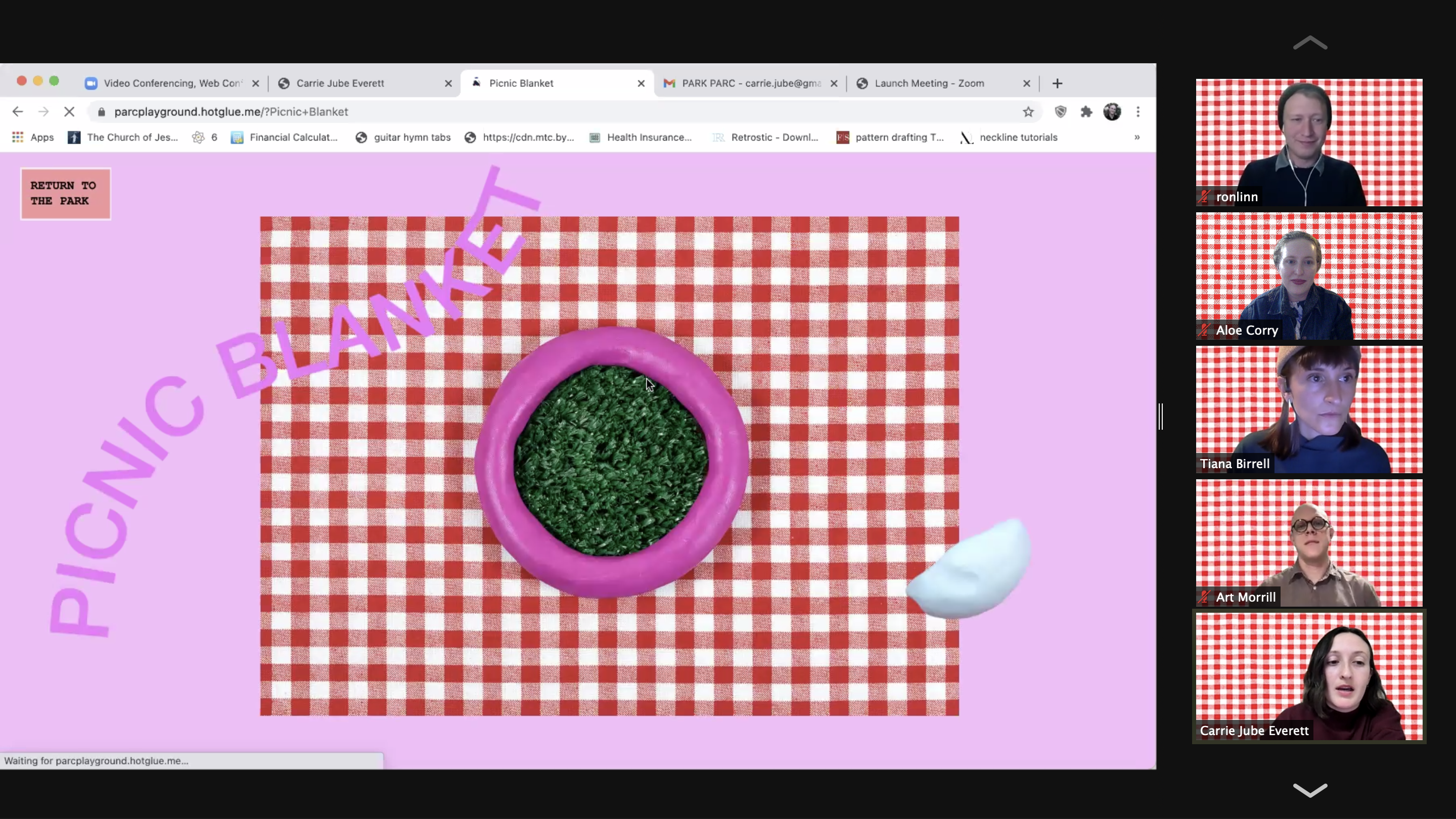
Tiana: This body of work incorporates a lot of small, plastic-like, lumpy forms. Where does this visual language stem from? They feel almost like characters. Do you regard them in this way, or do they have some other significance?
Carrie: I think that it's been a progression, but the original inception of the weird organic forms [throughout this work] actually started with a project I was doing a couple of years ago. I decided to spray paint this pillow inside of a pillow--basically polyester batting--and my idea was to make it like an artificial cloud, [something] that felt kind of ambiguous and in a middle ground. Something that was kind of natural, mossy--but then when you get up close it looks sticky or plasticky, very artificial. That's kind of where everything started, and then from there the ball kept rolling. I came across different materials to work with, and would often draw from my observations of things in the natural world and turn them into something of my own. That is the genesis of all of the little shapes and forms that I've been using.
I do think of the [shapes] as characters. I don't know if it started out that way...but it sort of evolved into the [shapes] becoming these living breathing organisms that grow, and change, and evolve, and move, and have a loose narrative attached to them. I like thinking of them in that way, [rather than] super tied-down, or stagnant, or anything like that.
Tiana: We have this carrying over of forms from previous [work] into this space...you’re developing a “Carrie language,” a language of artificial color mixed with organic forms.
Ron: The shapes feel kind of like participants at the picnic, and also maybe the items that might be part of the picnic spread.
Tiana: There is a great playful quality to the work. Do your materials exist together, fixed, as sculptures? Or do you keep the elements separate to mix and match, and play with indefinitely?
Carrie: Yes, I definitely view them as mixing and matching, and since [the shapes are] all in my head evolving all the time, I like being able to look at them as not just part of one photo, but almost as if they're moving from one photo to the next--being able to look at their evolution as I put them in different contexts. I'm building a loose non-linear narrative around these forms by using them repeatedly instead of just having them stationary and just in one context.
Tiana: I’m curious to how you contextualize the gifs [you’re using]. You're talking about moving [objects] around indefinitely, but even just looking at this image here: it's a repeated, constant gesture where the round circular ball repeats over and over again in that indefinite loop. I feel like that’s a bit of a contrast to what you're talking about.
Carrie: I think that has to do with the digital platform, which was really interesting to work with: to think about how to change and adapt my work to fit in a digital gallery rather than [something to be viewed] in person. I think making gifs was interesting to me because they put you in this continuous mesmerizing loop...You can click out of [the gif], and then you're stuck in another little loop--they create these little mini narratives within the larger narrative...Viewers don't have to be stuck in one place that I’ve decided on. [Instead] viewers have the freedom to experience [the show] in whichever little loops they decide to enter.
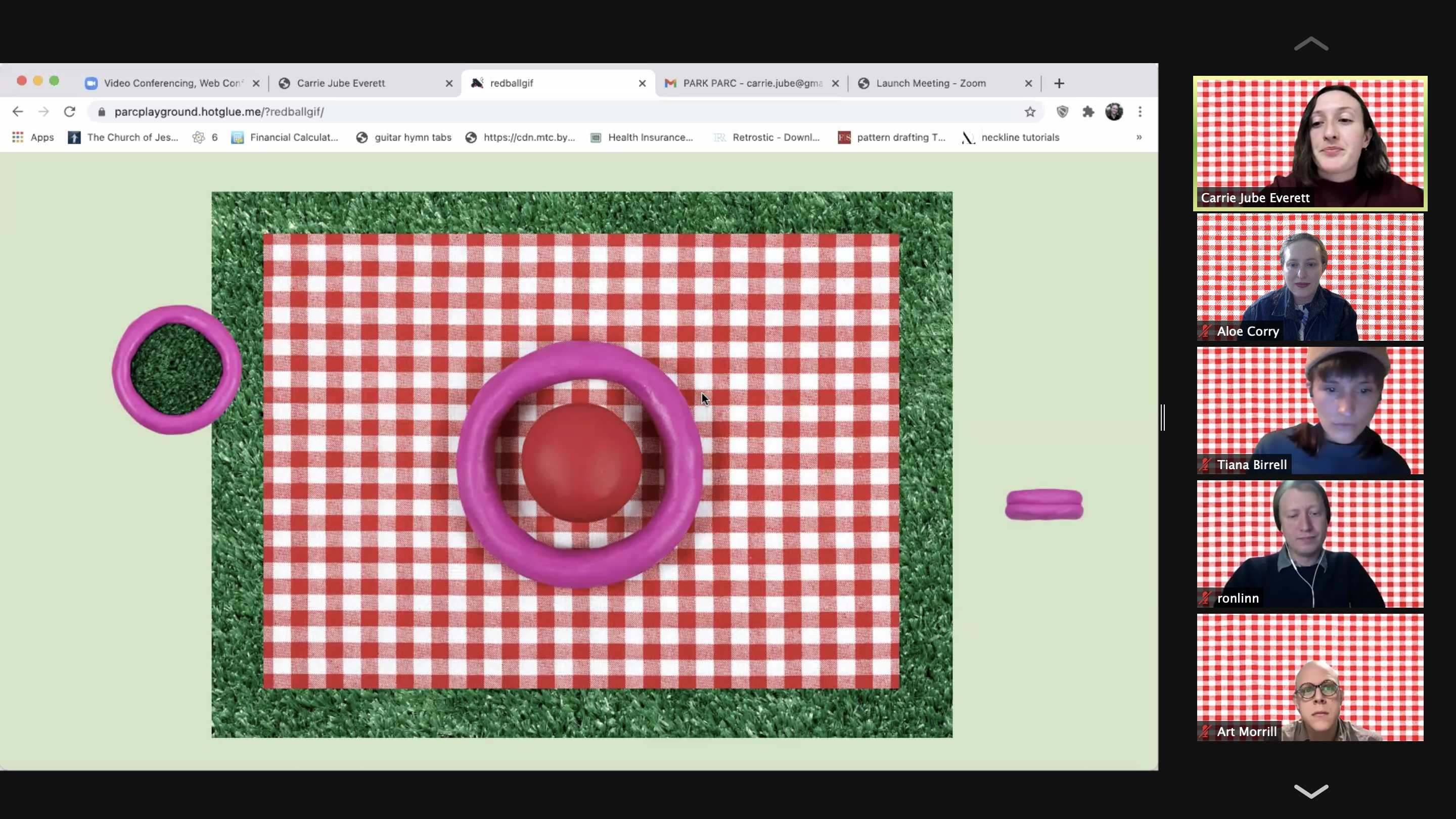
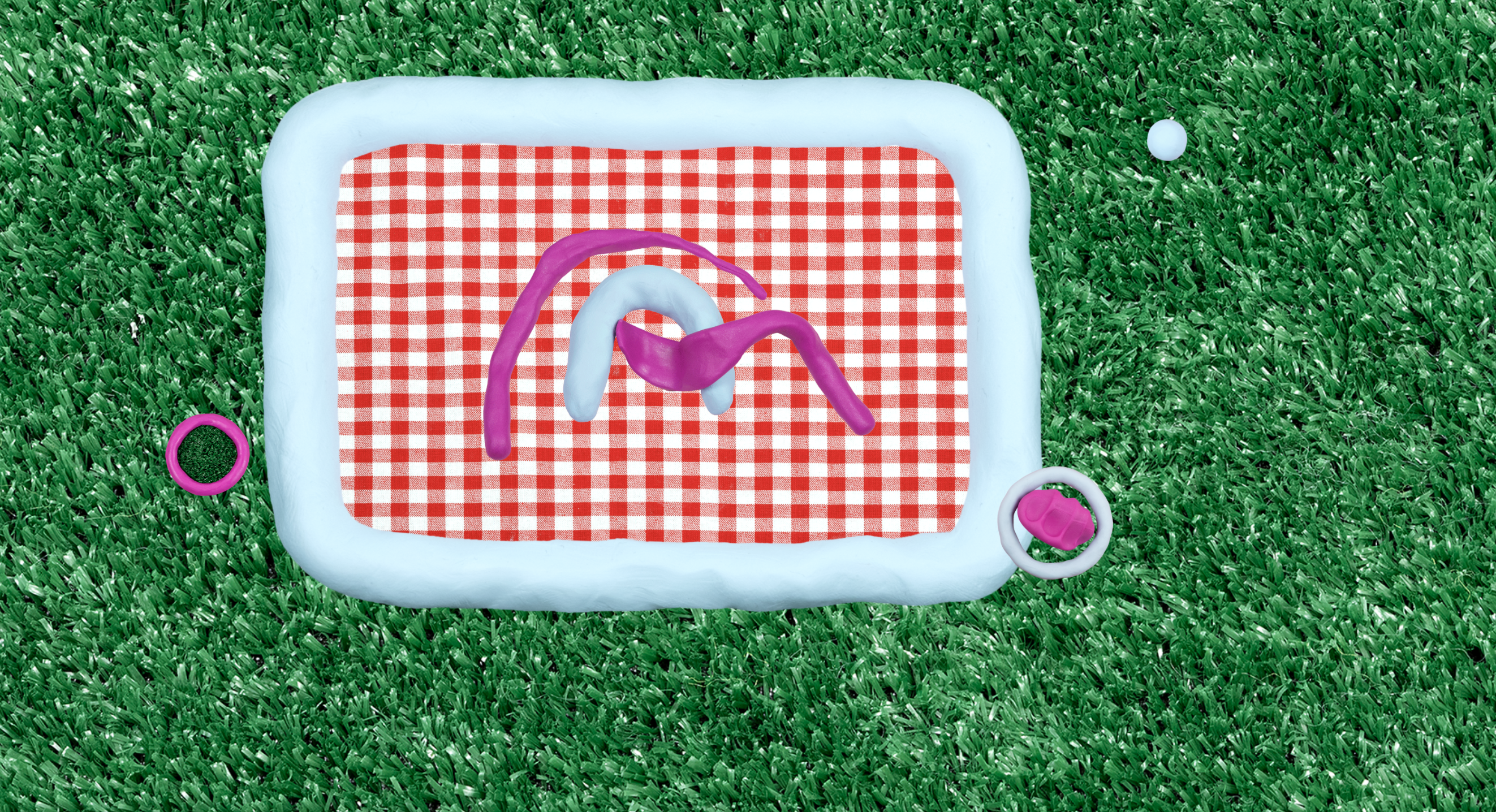
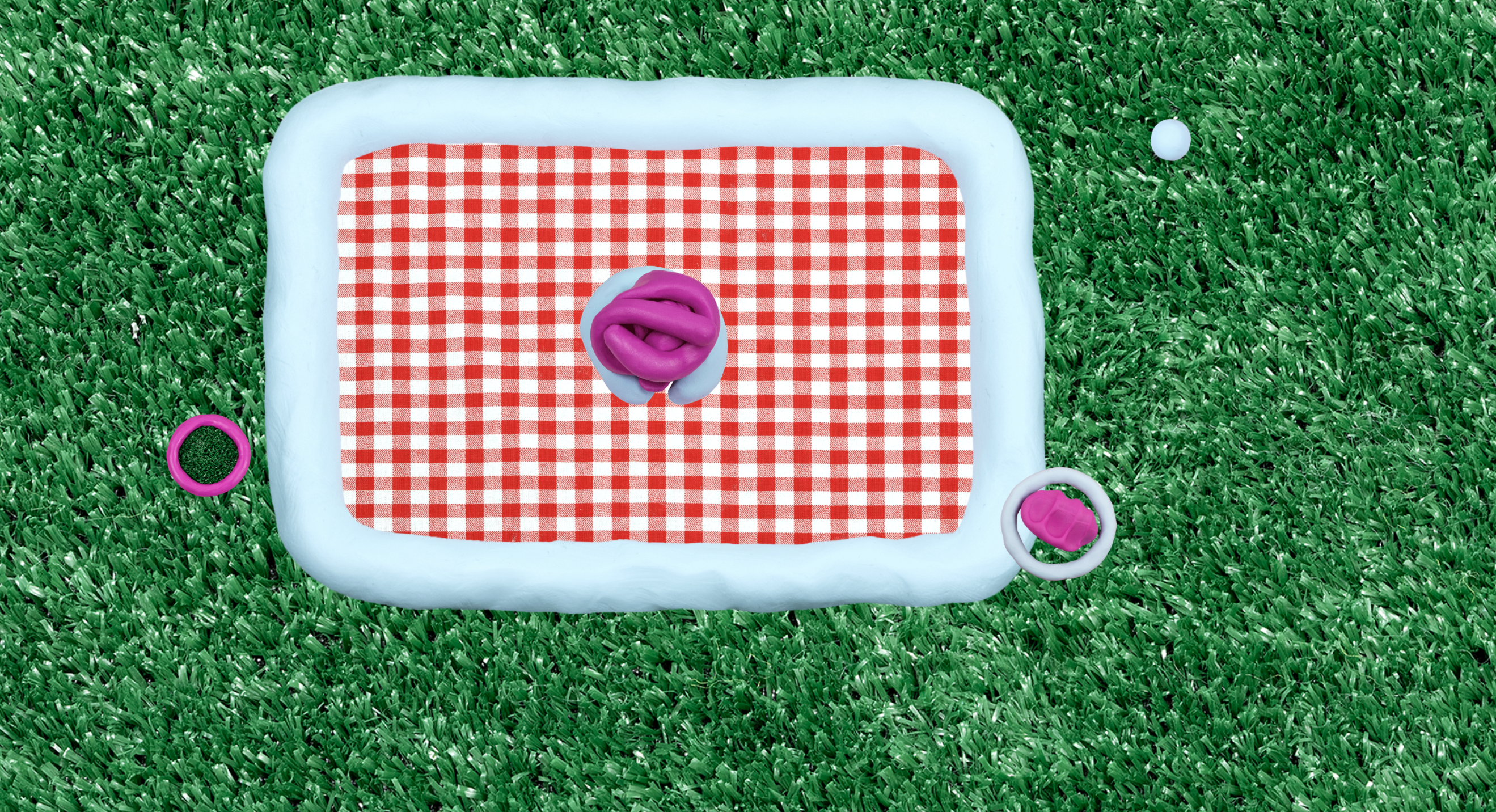
I thought of [the utensil] gif more directly in the context of the picnic blanket. It was obvious: you eat at a picnic. I wanted to incorporate that, but in a way that felt more ambiguous. Who is doing the eating or what are they eating? Are they even eating anything, or is it more like a transformation? Which things are alive, which are animate or inanimate objects? What is reality, what is actually natural, and what is contrived? I like the idea of having a transformation that feels cyclical, to have something as static as a fork and knife evolving and changing and almost becoming the organs that might be eaten.
Tiana: How do you think about texture as you begin a body of work, and why are you drawn to these textures that seem to recur throughout all of your work, not just this show?
Carrie: Texture is really really big for me. I think that I'm just naturally drawn to a lot of the textures that make it into my work, but I also think that there's significance in the way that they [help me to] understand this weird gray area between artificial and the real. A lot of the textures feel kind of plasticky or very artificial and contrived or slick. Then I’ll have the texture of fabric, something that's a little softer, some natural fibers, but then use them in an artificial way. I am thinking a lot about how I can push that gray area and explore it and kind of just dive into it, instead of trying to draw a line where the distinction between [the artificial and the real]...Texture helps me create this effect of being simultaneously natural and artificial at the same time.
Tiana: I'm thinking about your use of the words “plastic” and “plasticity.” When I hear the word “plastic” I think of a certain type of color, or a certain type of sheen, but I also think about the definition of that word meaning “easily malleable.” It's really poignant with what we're seeing in the gifs and in your other images. You capture this transformative nature, this malleability and plasticity.
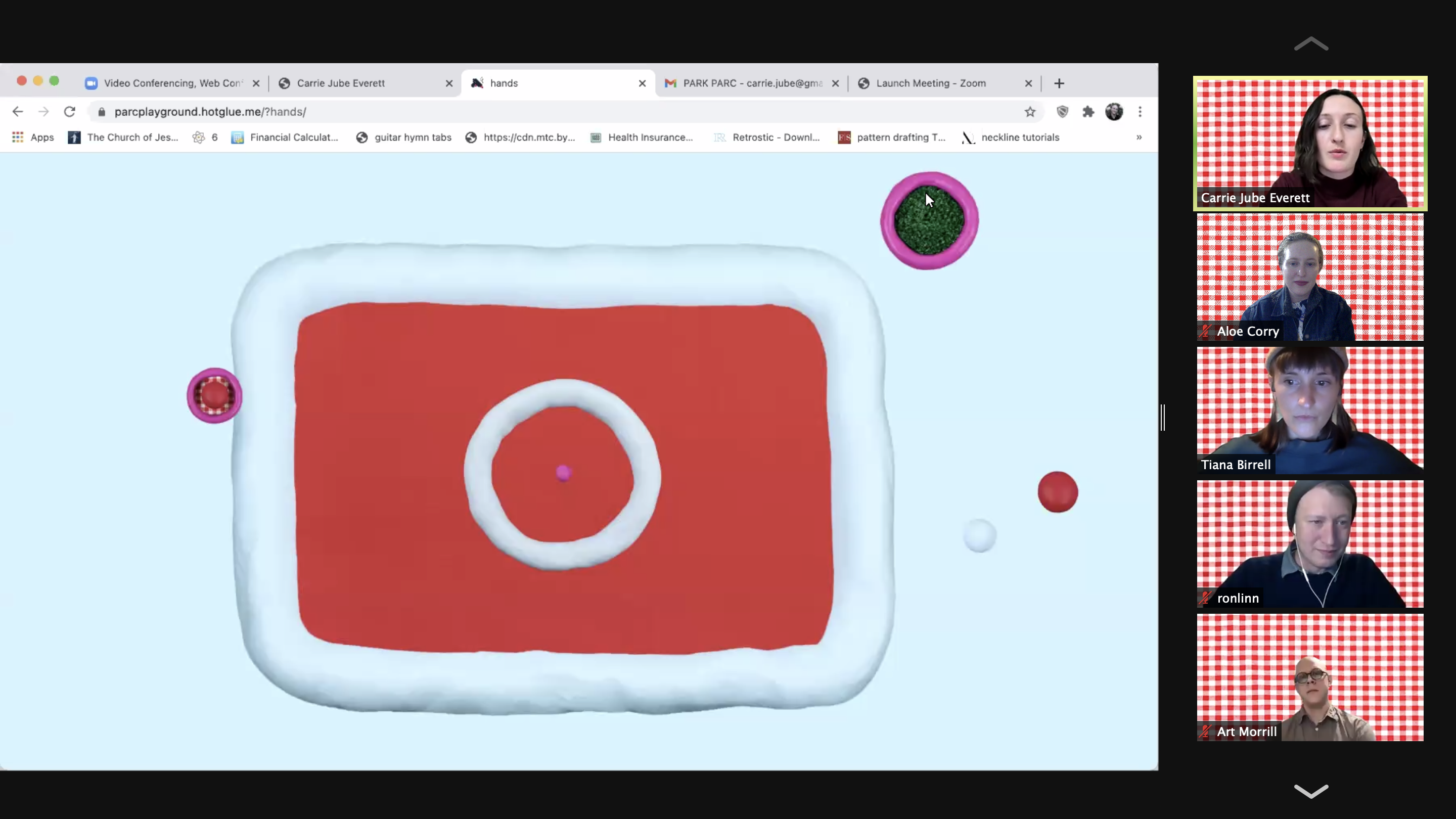
Carrie: Yeah, I think that [the grey area] feels like a comfortable and familiar space for me to sit in and enjoy being in. It could be uncomfortable seeing [these textures]--so artificial or so plastic, and plastic is so bad for you. But in that area, these textures feel apart from that reality and become more of a headspace or a state of mind that you could slip into and lose yourself in, start daydreaming in. I don't know if you’ve ever seen the tv show The Good Place, but to me it feels like Janet's void, a headspace that can be filled in any way that you want it to be.
Ron: The reliance on these familiar textures also feels like an inviting move offered toward the audience; even in a digital space like this that you can’t physically enter, it feels so tactile.
Tiana: Which parts of your picnic should be eaten, and which shouldn't?
Carrie: I like this question. I immediately think of Charlie and the Chocolate Factory actually, and the scene where they all go into a big open room and it’s a huge meadow of grass and beautiful things--it's made to look like a landscape with hills and trees and fruit, and everything there is edible, everything is candy. I like thinking about my work being like that. You can eat any of it or none of it; everything is edible.
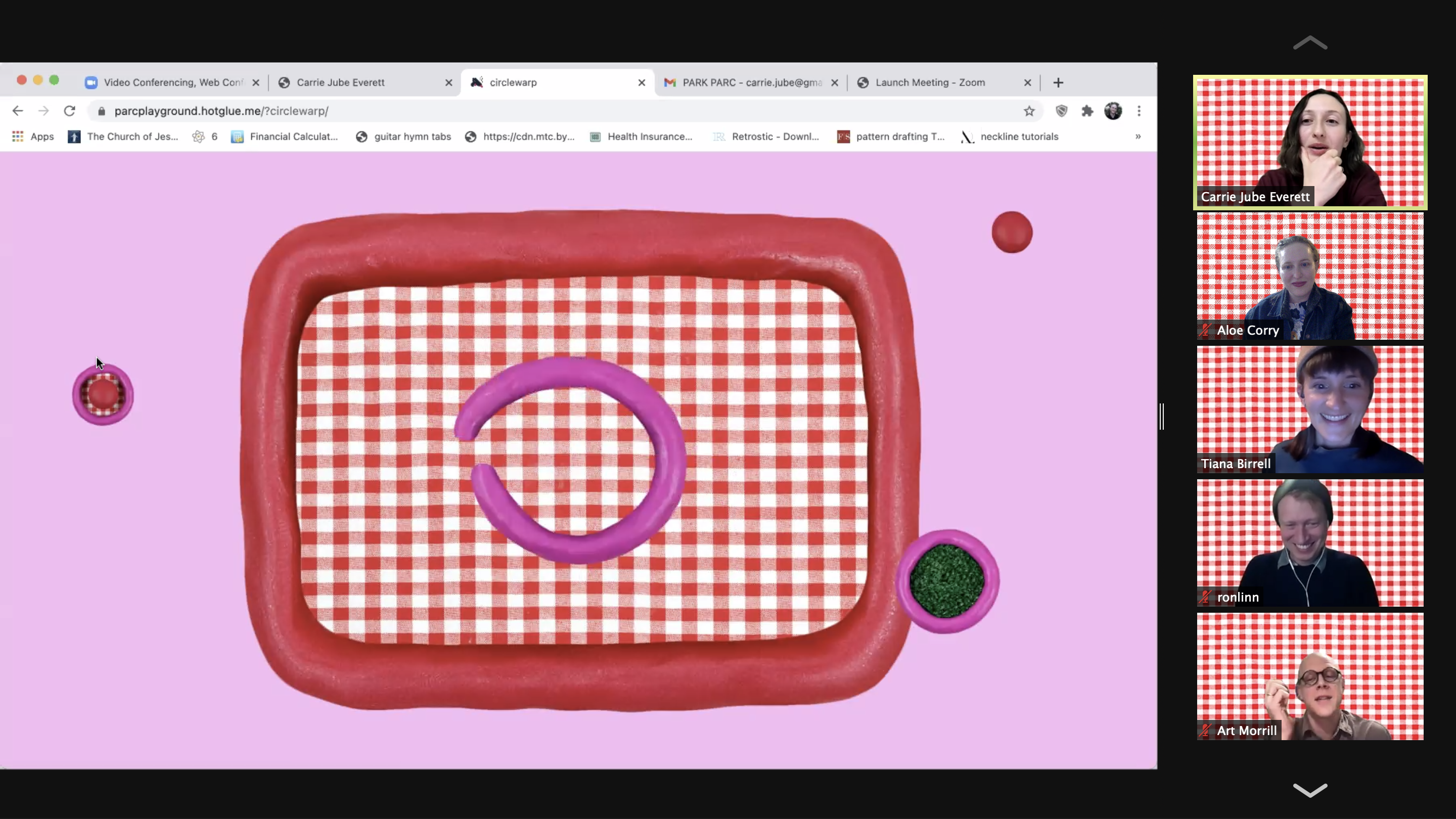
Tiana: I am experiencing a visceral reaction upon seeing your work. The colors you use in your work are fun and playful, and so are colors of candies. They are marketed that way so that children will want to touch them and eat them. Maybe I'm a child too, because I also find them really alluring.
Carrie: There is a weirdness to everything [in the work] and it's not all delicious. There's maybe a point where you might stop and think about something that seems kind of weird or off-kilter. Candy is not good for you, it's sugar and artificial colors, but we all love candy and eat it anyway. There's this kind of tension between what is actually good for us, and what is alluring, and why it's alluring. I'm not really addressing [this tension]; I’m focused on why [these objects] are alluring.
Tiana: This work was conceived specifically for this show. How did the virtual platform influence the developments of this work?
Art: Do you think there are any new aspects from this show that might continue in your work?
Carrie: It was a really interesting challenge to work with the space. The default is to have a gallery or white walls that you fill. In my past exhibitions, I reacted to the physical space, and using a digital space was definitely a transition. There were elements of my physical work that I couldn't replicate in a digital space, but what I found interesting were the different possibilities and ways that I could expand what I was thinking about in a way that wasn't possible in a physical space. For example, generating a moving image and seeing what I could do with navigation, having links to click on and create a mini narrative through, or just using this digital space that's endless. It increases the ambiguity of where the artwork starts and ends. Those aspects definitely influenced the way I made the work for the show.
Tiana: From a curatorial standpoint, the elements that I'm hearing you bring up about moving from a physical wall and objects you can walk around--these were questions that PARC was asking as we built this park. We were also asking ourselves questions about reality, questions about artificiality--what does it mean to reference a park that is very grounded in the physical but then not actually present a physical park? Your work seemed like a perfect way to open the park because your work exists in this duality between the natural and the artificial.
Aloe: One of the things I really love about what you did with this show, Carrie, is that you resolutely insisted on using fake grass. There's not even a shadow of an actual, living, breathing plant--but your work breathes anyway, through the movement and positioning [of textures]. I love that you went straight to that AstroTurf-y grass. I know what that texture is right away. I can feel it when I look at it.
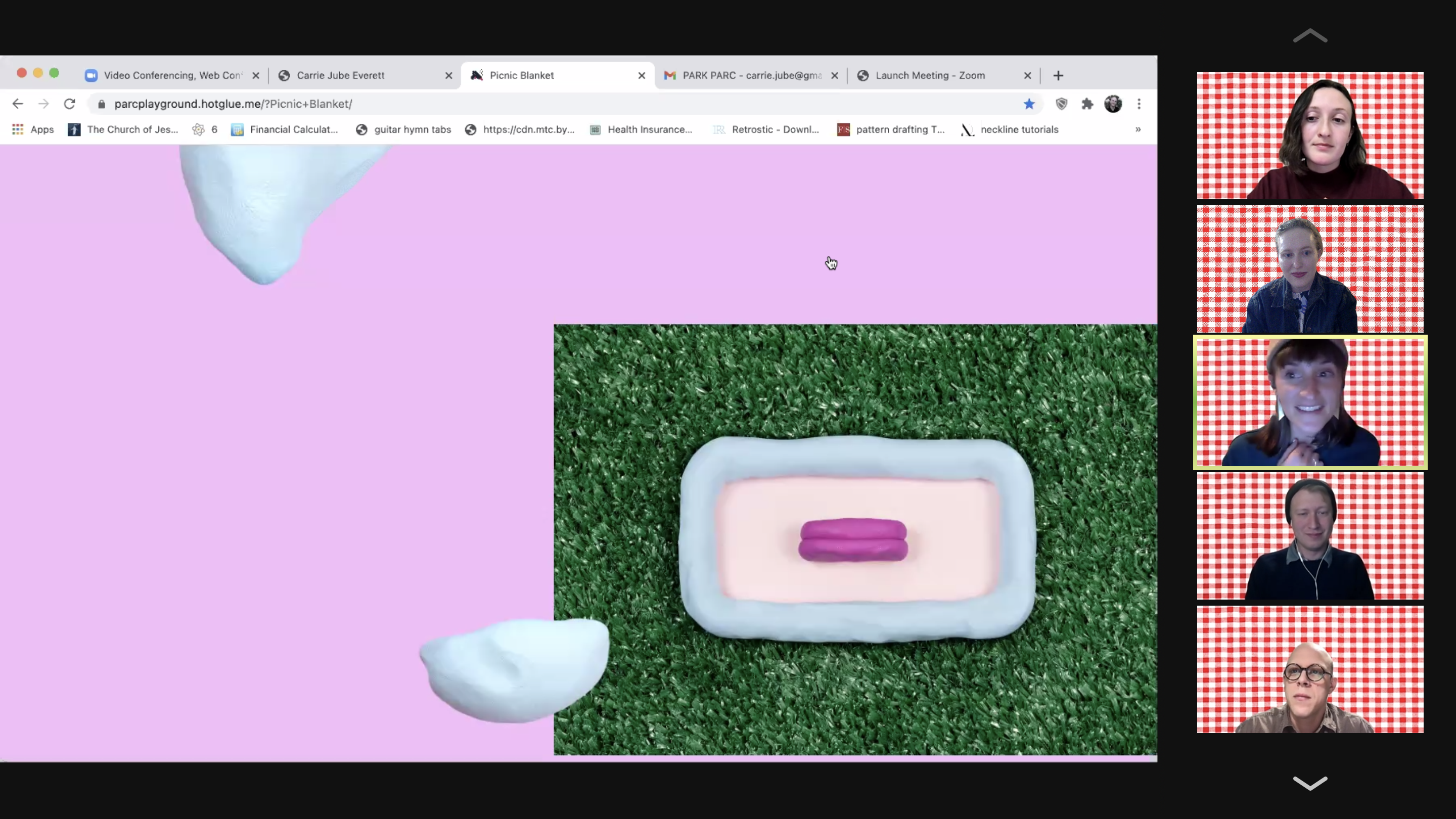
Tiana: That high gloss, that veneer, that textural element brings [the work] into the physical realm, maybe because I’m imagining what it's like to touch the grass. We can almost feel like we're really touching the grass. It engages the senses in a really unique way.
Another question: It’s easy to get lost in this work because of the choose-your-own-adventure style of navigation. How did you think about navigation as you designed the structure of the various pages? It is reminiscent of walking through the various galleries of a large museum like the Met. Do you think of this show as a sort of labyrinth?
Carrie: I hadn't necessarily thought of [my show] as the building of a labyrinth. Initially I had just thought of making a continuous scroll, but then I started feeling like [the work] needed more space and I started incorporating more little icons that could be clicked on. Then I thought it could be interesting to push that idea and make it a space that is endless, cyclical and nonlinear. I like the comparison to the Met, because in the Met you can get lost in circles and find yourself accidentally running into the same rooms again and again. [This is echoed in] the little mini cycles of gifs we’ve discussed. [My labyrinth] doesn't feel scary or dangerous--it’s not like a mythical labyrinth where there's a monster waiting somewhere to get you. The navigation pushes and pulls the viewer in a way I hadn’t originally expected.
Aloe: Something I love about your structure is the feeling of finding secrets when clicking on images.
Carrie: I wasn't sure exactly how intuitive the site would be, or how much would be left up to chance. I played with different levels of accessibility and the idea of having text telling people when things were clickable, but I decided that I liked it better when [the links] would be a little discovery or secret; that not maybe not everyone would find that every link, but [the finding of them] would be really satisfying. As I navigate the show myself, I have preferences for which images I'm drawn to click on, and I'm sure it's different for everyone. That’s one of the nice things [about the structure]; I can’t anticipate how viewers might experience it because everyone will find different links in different sequences.
Sarah: The work feels like multiple picnics on the same blanket, in the same way that people can use the same materials to create many different experiences. You can go to the Met over and over and will have a different experience every time because of how we travel through space differently, and it’s that way with this. That familiarity of creating lots of different experiences and memory is interesting to me - this work seems to function in tandem with memory in the way we do with ‘real-life’ experiences.
Ron: When Art and I were discussing your work, we really related your show to Choose Your Own Adventure books and wanting to find every path through, and the excitement in seeing that narrative develop and diverge in surprising ways. We really enjoyed that feeling here, trying to find every path, but also not quite sure if we have discovered everything.
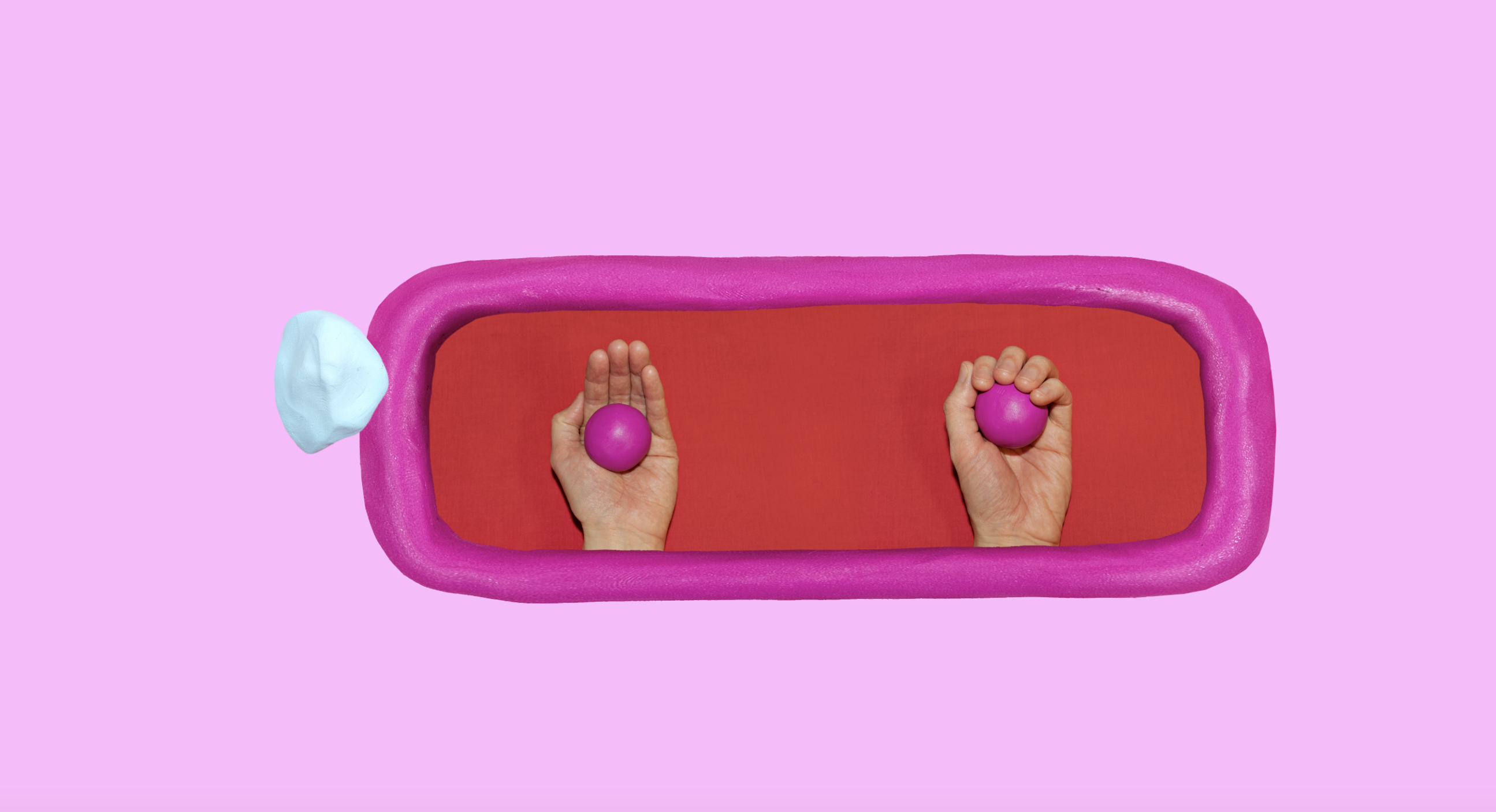
Tiana: Now I'm feeling like I need to go back and make sure I've truly discovered all of the little secrets in all of the little corners [of the show].
Carrie: I'm not sure that I've discovered every way that you can navigate through. [In terms of] Choose Your Own Adventure, I was thinking about how these different pairings of gifs and other elements [create so many] different options. I don't know that I’ve specifically navigated through every area in every way--it’s open for me as well, it’s interesting to not really be sure that I've figured everything out.
Tiana: We have one more question: Do you like going on picnics? What is your ideal picnic like?
Carrie: I do love picnics. I love being outside and I think my ideal picnic is just a simple one: being somewhere that's not super close to a busy street, where there’s nice soft grass. It's got to be in a park instead of a rocky trail--in my mind that's not really a picnic, that's a hike--yeah, I'd like it to be on a nice soft flat shady stretch of grass, on a nice blanket. Just getting to be out there, in the space, feeling the air, hearing the noise of the wind through the trees and the birds. I think that's the ideal picnic--and also eating something.
Tiana: As you’re talking, I am really aware of my senses. You're describing the wind and the warm sun or the shade. Then I’m thinking about this piece that we're looking at here and the lack of those other senses that [we’re talking about]. As we’ve said, the texture [in the work] really holds a lot of weight. But the fact that I'm not getting those other [sensorial inputs] almost allows me as the audience to map my own [picnic alongside yours]: my favorite sound that I might hear or my own favorite side dish that might be a companion to these pieces that we see here. I'm mapping myself into your picnic, into your space, and I find that really exciting.
Carrie: I have talked to [my husband] about this many times: how we can't recreate an exact moment, of being [at a picnic] and feeling the grass or hearing the birds--we can't really ever fully get to that moment. And in a way I feel like it's better not to try to replicate [a specific moment], but to instead try and create something new that sits alongside these [specific] experiences.
RETURN TO
THE BOARD
ENTER THE
EXHIBITION